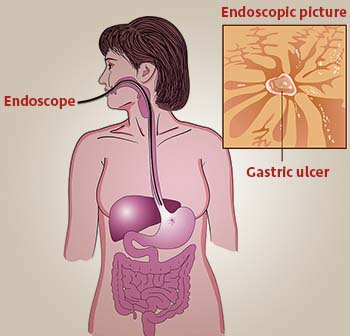Documentation of an ulcer requires either a radiographic (barium study) or an endoscopic procedure.
Radiographic Studies (Barium Study): Barium studies of the proximal gastrointestinal tract are still commonly used as a first test for documenting an ulcer. Double-contrast study provides detection rates as high as 90%. A Duodenal Ulcer appears as a well-demarcated crater, most often seen in the bulb. A benign Gastric Ulcer also appears as a discrete crater with radiating mucosal folds originating from the ulcer margin. Ulcers >3 cm in size or those associated with a mass are more often malignant.

Endoscopy: It is most specific approach for examining the upper gastrointestinal tract. Endoscopy facilitates direct visualization of the mucosa, photographic documentation of a mucosal defect and tissue biopsy to rule out malignancy or H. pylori. Endoscopic examination is specifically helpful in identifying lesions which are too small, to evaluate irregular radiographic abnormalities, and to determine a source of blood loss. Occasionally, specialized testing such as serum gastrin and gastric acid analysis or sham feeding may be needed in individuals with complicated or refractory Peptic Ulcer Disease.















